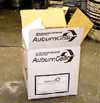Reviewer's Notebook: Auburn Gear Sure-Grip Limited Slip Differential


An open differential typically provides equal torque to both wheels. The differential case is bolted (in the case of the Chrysler 9 1/4" axle, there are 12 bolts) to the ring gear. The driveshaft turns the pinion, which, in turn, turns the ring gear and the differential case. When both wheels have traction, the differential case rotates and the differential gears within the case turn both axles along with the case.
The difference between an open differential and a limited slip differential becomes apparent when the wheels must turn at a different rate (around a curve) or when there is a significant traction difference between the two wheels. Under these circumstances, the differential case continues to rotate in both types of differentials. However, in an open differential, the axles are no longer willing to be rotated at the same rate. The gears within the differential case then begin to rotate, so that as the differential case rotates, the axles turn at different rates. In the extreme case, only one axle turns at all. The limited slip differential puts a limit on how much differential is allowed to exist between the rotation of the two axles. Around a curve, the LSD should function as an open differential, allowing differential rates of rotation. However, at some pre-set limit (the "load" of the LSD), the clutches begin to bind, and force the axles to rotate together along with the differential case.
The "load" is key. If the load is too tight, the back axle will want to break loose on a slippery curve. If it's too loose, you compromise the advantage. As the LSD wears, its operation will also be reduced. One disadvantage with an Auburn unit is that, because the clutches bind against the differential carrier, they are essentially disposable. Other types of LSDs use two clutch surfaces facing one another, such that the clutches can be replaced when worn. However, the Auburn units are well known for their durability, and will last a good long time.
In a recent project I described how I installed an Auburn LSD unit in the rear axle of my 1983 Dodge Ramcharger. I have since driven my truck over thousands of highway miles and quite a few off-road miles. I have found both the road manners as well as traction aid of the Auburn unit to be excellent. I highly recommend this product as a traction aid to a multi-purpose 4x4.
If you're interested in learning more about Auburn LSDs, please contact one of our many drivetrain product sponsors.



 Your Privacy Choices
Your Privacy Choices